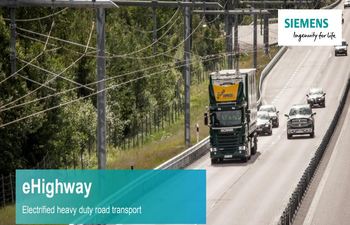Knowledge Hub
Update on Electric Vehicle Adoption Across U.S. Cities
2020
Author(s): Bui A, Slowik P, Lutsey N
This briefing assesses the U.S. electric vehicle market in 2019 and the policy actions by cities, states, and electric power utilities that were driving it.
The year 2017 was another record-breaking one for renewable energy, characterised by the largest ever increase in renewable power capacity, falling costs, increases in investment and advances in enabling technologies.

This presentation by Mr. Patrik Akerman, Head of eHighway Business Development, Siemens AG (Mobility Technology & Innovation Highway) presents a context for Electrified Roads for HDVs and address the following questions on electrification of Heavy-Duty Vehicles (HDV) Transport: 1. What are electrified roads for HDVs 2. Development of eHighway 3. The potential benefits 4. Possible roadmap from initial deployment to system
The 2017 edition of the REN21 Renewables Global Status Report (GSR) reveals a global energy transition well under way, with record new additions of installed renewable energy capacity, rapidly falling costs, particularly for solar PV and wind power, and the decoupling of economic growth and energy-related carbon dioxide emissions for the third year running.

This Presentation by Acacia Smith, Manager – Environmental Affairs, IRU (International Road Transport Union) is a result of iIRU's voluntary commitment to reduce CO2 emissions by means of promoting Eco-driving. This presentation contains Individual training reports to promote ECO-driving Course for all professional drivers to make them aware of road conditions and the impact of their driving style on vehicle efficiency.
The year 2015 was an extraordinary one for renewable energy, with the largest global capacity additions seen to date, although challenges remain, particularly beyond the power sector.
Renewable energy continued to grow in 2014 in parallel with global energy consumption and falling oil prices. Despite rising energy use, global CO2 emissions associated with energy consumption remained stable over the course of the year while the global economy grew.
Cities are directly responsible for around two thirds of global final energy use as well as for significant indirect consumption of energy that is embodied in materials, products and other goods.
This inaugural Asia and the Pacific Renewable Energy Status Report provides a comprehensive overview of renewable energy developments in selected countries of the region.
2018 SADC Renewable Energy and Energy Efficiency Status Report
2018
Author(s): Stiles G, Murove C
The 2018 SADC Renewable Energy and Energy Efficiency Status Report builds on the initial status report for the Southern African Development Community (SADC) issued by REN21 in 2015.



